What Do Armadillos Eat?
The armadillo is one of the strangest little creatures found in the Americas. Its name in Spanish translates to “little armored one,” and refers to its armored shell made up of dermal bone. In total, there exist 21 known species of armadillo, all of which live in North America and South America. Most species live in temperate, warmer habitats ranging from rain forests to grasslands to deserts. They range in size from around 5 to 6 inches long to nearly 59 inches long. One species, Tolypeutes, exhibits a unique behavior in that it can roll into a ball when threatened. Armadillos feature prominently in American literature, arts, and culinary traditions. Additionally, they have been used extensively in scientific research. This is due to the fact that they are one of the few animals known to contract leprosy. Still, do you know the answer to the question, “what do armadillos eat?”
In this article, we’ll attempt to answer all of your questions concerning what armadillos eat. We’ll start off with a general overview of what armadillos generally like to eat. Next, we’ll discuss how they go about hunting and foraging for food. Then, we’ll compare what they eat in the wild versus what they eat in captivity. Finally, we’ll end with a brief discussion of what baby armadillos eat. So, let’s get this conversation rolling as we answer the question, “what do armadillos eat?”
What Do Armadillos Like to Eat?
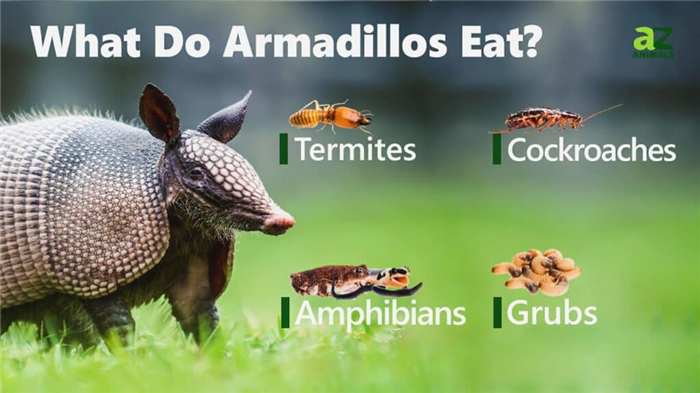
Armadillos eat a wide variety of prey including termites, cockroaches, small amphibians and reptiles, and grubs.
Armadillos are omnivores, meaning that they eat both plant and animal matter. That being said, insects make up the bulk of their diet and may constitute nearly 90% of what they eat. However, there exists a lot of variance in the dietary habits between different armadillo species. While some armadillos eat a wide variety of food, others are specialist hunters, preferring to dine on just a few different prey animals. Although they prefer live prey, armadillos are not opposed to eating carrion as well. As opportunistic eaters who eat both plants and animals, an armadillo will end up eating just about anything. For the purposes of this article, we’ve identified 10 foods that most armadillos like to eat. This is not to say that all armadillos eat these foods, simply that they occur frequently in an armadillo’s diet. The 10 foods that armadillos like to eat include:
- Insects
- Grubs
- Invertebrates
- Small reptiles
- Mushrooms
- Vegetables
- Fruits
- Seeds
- Eggs
- Small amphibians
How Do Armadillos Hunt and Forage For Food?
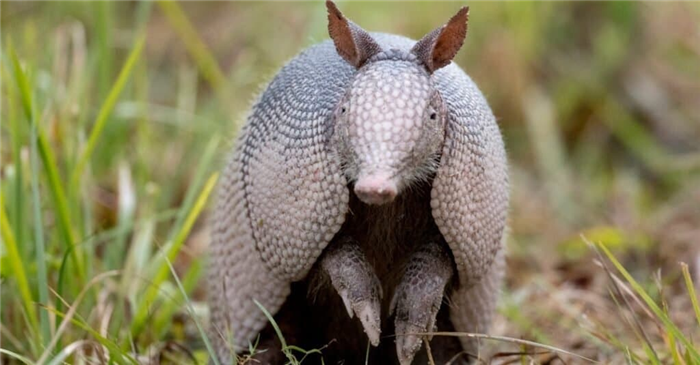
Armadillos are prolific diggers and are experts at finding insects under the soil.
When hunting and foraging, armadillos rely on their senses to help them find food. That said, they use some senses more than others. For example, armadillos possess very poor eyesight. This makes sense, given that most armadillos are nocturnal. As a result, they mostly rely on their keen sense of smell to find food. While hunting for food, they can smell prey and other morsels located nearly 8 inches below the ground. Meanwhile, they also have strong hearing abilities, although they mostly rely on their hearing to avoid predators. Additionally, armadillos are equipped with long hairs on their undersides. These long hairs act like the whiskers on a cat and are very sensitive to touch. They allow an armadillo to closely feel the environment they are walking on. This helps them to detect food, and also to locate suitable areas for them to dig.
Armadillos mostly find food by digging through dirt and soil. They are prolific diggers, and use their sharp claws to sift through the ground to find food. An armadillo can dig out a burrow in about 15 minutes, so it can quickly find food located a few inches below ground. They possess 5 claws on their hind feet, and between 3 to 5 claws on their forefeet. The claws on their forefeet are thicker and heavier, which makes them perfect for digging. Unlike most other mammals, armadillos do not have canine or incisor teeth. Instead, they continuously grow peg-like teeth, of which they possess between 14 to 18 per jaw. When not sleeping, armadillos are usually hunting or foraging. They do the majority of their hunting at dusk and dawn when insects are usually most active.
What Do Armadillos Eat in the Wild?
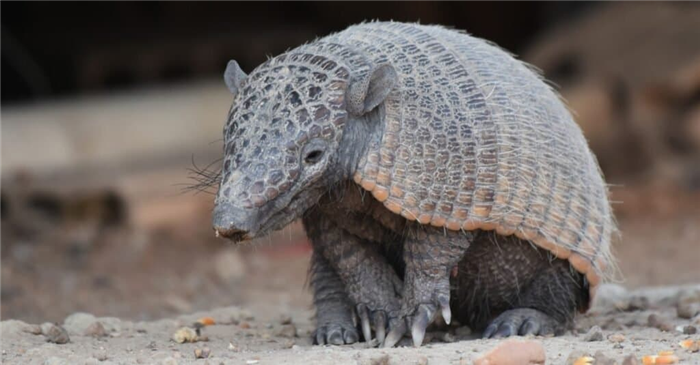
Armadillos are opportunistic eaters that will eat pretty much anything they can find, although some species will eat almost exclusively ants and termites.
In the wild, armadillos will eat just about anything that they can catch or find. As opportunistic eaters, they aren’t particularly picky, although certain species do show preferences towards particular foods. For example, while most armadillos eat insects, grubs, and invertebrates, some specifically target ants and termites. Other insects that armadillos eat include cockroaches, grasshoppers, beetles, and wasps. Additionally, they will also eat spiders, scorpions, and snails. Along with insects and invertebrates, wild armadillos will also target bird and reptile eggs. On occasion, they will even eat small reptiles and amphibians such as snakes and frogs. As for plants, armadillos eat a wide variety of plants including mushrooms, fruits, vegetables, and seeds. In total, armadillos have been reported eating over 500 different foods. When available, they will also eat carrion, although they tend to prefer live prey. That said, they’ll never turn down an easy meal.
What Do Captive Armadillos Eat?
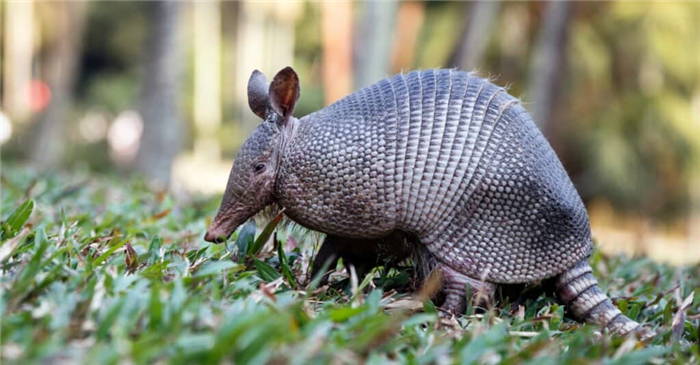
Some armadillos can eat up to 200,000 ants in a single day.
Armadillos do not make good pets and it is illegal to own an armadillo as a pet in many places. However, they are still commonly kept in zoos, where people enjoy watching these unique creatures in synthetic habitats. Most zoos feed captive armadillos a predominantly insectivorous diet. This diet includes a number of different insects including grasshoppers, ants, termites, beetles, and grubs. Along with insects, many zoos also feed their captive armadillos a limited amount of fruit. However, depending on the species, some armadillos may require a more specific diet. For example, giant armadillos, southern three-banded armadillo, and pink fairy armadillos mostly eat ants and termites. These animals require a large number of insects to stay well fed. Just one giant armadillo can eat up to 200,000 ants in a single day. Such a large number of insects means that caring for these giant creatures can be difficult.
What Do Baby Armadillos Eat?
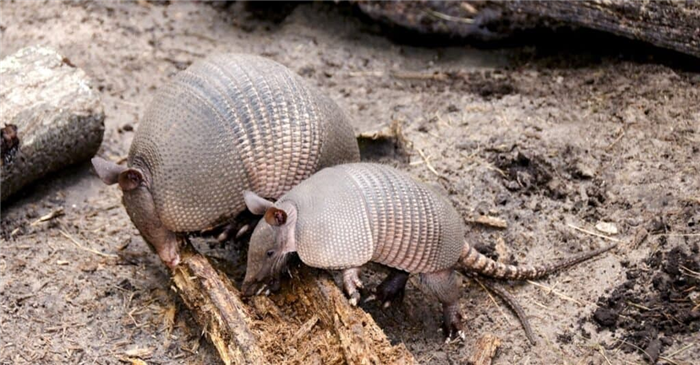
Armadillos typically have large litters, and the babies are called pups.
Most armadillos live between 7 and 20 years in the wild, but they can live longer in captivity. Baby armadillos are called pups. A female armadillo can give birth to anywhere from 1 to 12 pups at a time, depending on the species. Meanwhile, the nine-banded armadillo almost always gives birth to identical quadruplets. At birth, the pups possess soft, leathery shells rather than hard shells. On average, the mother will nurse the pups for between 2 to 4 months, but this can vary depending on the species. Once the pup is old enough, it will begin to eat the same food as an adult armadillo. By around 9 to 12 months old, armadillos are fully mature and venture out on their own.
What Bugs Do Armadillos Eat?
Armadillos have relatively low metabolic rates and carry very little fat on their bodies. Because of this, these animals tend to avoid the cold, preferring, instead, to live in temperate and warm climates like those found in rain forests, grasslands, and semi-deserts. Even in these habitats, to save on energy reserves, armadillos sleep up to 16 hours a day. Much of their waking lives is spent looking for food, primarily insects.
Most armadillo species forage in the early morning and evening hours for a variety of invertebrates and insects, including beetles, grubs, and worms. Because, like many burrowing animals, armadillos tend to have extremely poor eyesight, their hunting skills rely on their abilities to smell their food. Fortunately, these animals have exceptionally keen noses.
Typical Ants and Termites
Ants and termites are favorite foods among armadillos; their strong legs and large front claws help them burrow as deep as they need in order to find their favorite meals. Once the bugs have been found, the armadillo’s long tongue does an excellent job of extracting ants and termites from their tunnels. What’s more, armadillos secrete a particularly sticky saliva to help them hang on to even the most agile of insects.
Research shows that armadillos seem to be one of the few natural predators of the pesky fire ant. They have been known to dig into fire ant mounds during droughts when other insects are more difficult to find. While this might seem terribly unpleasant to anyone who has been bitten by an adult fire ant, armadillos tend to eat only the young, defenseless broods that are often located near the surface of the colonies.
What does an armadillo like to eat?
More than 90% of the armadillo’s diet is made up of insects and their larvae. Armadillos also feed on earthworms, scorpions, spiders, and other invertebrates. There is evidence that the species will eat some fruit and vegetable matter such as berries and tender roots in leaf mold, as well as maggots and pupae in carrion. Armadillos eat vertebrates to a lesser extent, including skinks, lizards, small frogs, and snakes, as well as the eggs of these animals.
This is a national Cooperative Extension resource
This work is supported in part by New Technologies for Agriculture Extension grant no. 2020-41595-30123 from the USDA National Institute of Food and Agriculture. Any opinions, findings, conclusions, or recommendations expressed in this publication are those of the author(s) and do not necessarily reflect the view of the U.S. Department of Agriculture.
© All rights reserved.
To provide the best experiences, we use technologies like cookies to store and/or access device information. Consenting to these technologies will allow us to process data such as browsing behavior or unique IDs on this site. Not consenting or withdrawing consent, may adversely affect certain features and functions.
The technical storage or access is strictly necessary for the legitimate purpose of enabling the use of a specific service explicitly requested by the subscriber or user, or for the sole purpose of carrying out the transmission of a communication over an electronic communications network.
The technical storage or access is necessary for the legitimate purpose of storing preferences that are not requested by the subscriber or user.
The technical storage or access that is used exclusively for statistical purposes. The technical storage or access that is used exclusively for anonymous statistical purposes. Without a subpoena, voluntary compliance on the part of your Internet Service Provider, or additional records from a third party, information stored or retrieved for this purpose alone cannot usually be used to identify you.
The technical storage or access is required to create user profiles to send advertising, or to track the user on a website or across several websites for similar marketing purposes.
What do armadillos eat?
HOW DO YOU GET RID OF AN ARMADILLO?
by Whit Gibbons
April 7, 2013
I recently received the following questions, which are variations of ones I have received in the past about armadillos.
Q: I have heard from friends who have a problem with armadillos digging up their whole yards. The last time I saw one was in Texas. Do they now occur farther east? Are armadillos mammals? What do they eat, and will they bite? What can be done about them?
A: Armadillos belong to a distinctive family of insect-eating mammals. Most of the 20 or so species live in Central and South America, but the nine-banded armadillo is native to the United States. Questions from people about how to get rid of armadillos in suburban neighborhoods have become more frequent as these armored burrowers continue to extend their geographic range. In the 1950s nine-banded armadillos were native to Louisiana and Texas, and they had been introduced into southern Florida, where, by the 1960s, they were very conspicuous. By the 1990s armadillos had moved up the Florida Peninsula into Georgia, Alabama and South Carolina. One biologist noted that “armadillos crossed I-20 going north in 1995.”
An armadillo’s food comes from beneath the soil, which they dig up with enormous shovel-like front feet as they search for beetle grubs living in the dirt. They also eat hundreds of other kinds of insects and worms. Part of their nuisance factor comes from their digging in soft soil, such as raised beds, tilled gardens, and watered lawns. On the positive side of the ledger, armadillos eat fire ants, which some folks might think outweighs any bad traits they might have.
If you can find an armadillo during daytime, removing it from an area is easy. Chase it down, grab the long tail, and lift it off the ground. Armadillos are near-sighted, so it is often easy to get close enough to catch them. I have never heard of an armadillo biting a person, but they do flail their feet trying to escape and can scratch. Let me qualify this message by saying I am not recommending this as a standard armadillo-removal technique for the average home owner.
Armadillos are primarily nocturnal and the way to catch one at night is to put a live mammal trap in front of an active burrow. Armadillos dig underground tunnels to sleep in. Arrange a pair of boards on edge to form a funnel leading from the burrow opening into the trap. Steel mesh traps with a door that closes when the animal enters can be purchased from stores that sell wildlife equipment. A caveat: if the trap is not securely built, an adult armadillo can rip it open with its powerful front feet.
What do you do with a captured armadillo? Releasing it several miles away in a wild habitat is one approach. Be sure you do not introduce it into an area where it could become a pest to someone else.
In addition to their bizarre appearance, a talent for long-distance dispersal, and the ability to eat fire ants, armadillos from Louisiana and Texas have one particularly unusual trait. They are, aside from humans, the only animals in the world that contract Hansen’s disease, more commonly known as leprosy. Armadillos in Florida, the origin of those moving north in the eastern United States, seldom if ever have leprosy. Documented cases are almost exclusively from armadillos in Louisiana and Texas.
Hansen’s disease, which is still prevalent in human populations in other parts of the world as well as in some regions of this country, is caused by a type of bacteria closely related to the one that causes tuberculosis. How leprosy is transmitted remains unclear because medical researchers have had difficulty culturing leprosy bacteria in the laboratory. One way to have bacteria on hand for research is to keep armadillos that have leprosy in captivity at medical facilities. Perhaps medical researchers should also study the eastern form of the armadillo, which apparently does not get leprosy, to discover what makes those armadillos immune.
If you have an environmental question or comment, email
(Back to Ecoviews)
5 Unique Facts About Armadillos
1. The Armadillo’s Shell Inspired the Making of Better Body Armor for Humans
Armadillo shells, made up of bony plates and coated with keratin (the protein that makes up your hair and nails), inspired researchers at McGill University in Montreal to create a protective material from glass plates. The material was 70% more resistant to puncture than a plate of the same thickness.
But, despite reports of bullets ricocheting off armadillos, these creatures are not bulletproof. In fact, predators can usually break their shells quite easily. So, the armor of armadillos is more like a hard-shell suitcase than a bulletproof vest.
